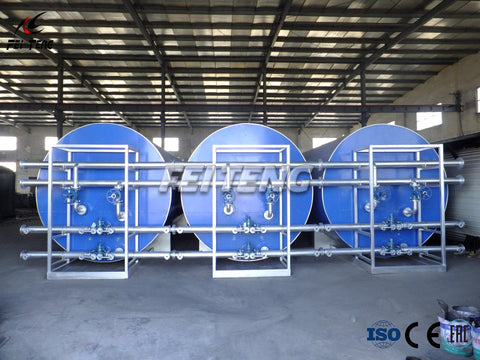
Bồn chứa bitum | FEITENG
GerryJarlShare
Trong xây dựng đường bộ hiện đại, bồn nhựa đường đóng vai trò là thành phần quan trọng trong hệ thống trộn bê tông nhựa đường. Với tốc độ gia nhiệt nhanh, hiệu quả năng lượng và dễ vận hành, bồn nhựa đường đã trở thành thành phần không thể thiếu trong các dự án xây dựng đường bộ. Bài viết này đi sâu vào đặc điểm, thành phần cấu trúc, phương pháp gia nhiệt, cách sử dụng và bảo dưỡng bồn nhựa đường, cung cấp tổng quan toàn diện về ứng dụng của bồn nhựa đường trong xây dựng đường bộ.

I. Đặc điểm sản phẩm
Bồn nhựa đường khác biệt với các thiết bị nhựa đường khác ở hiệu suất vượt trội. Đầu tiên, chúng tự hào về tốc độ gia nhiệt nhanh, tận dụng các công nghệ gia nhiệt tiên tiến để nhanh chóng nâng nhựa đường lên nhiệt độ mong muốn, nâng cao đáng kể hiệu quả sản xuất. Hơn nữa, thông qua các thiết kế được tối ưu hóa và hệ thống gia nhiệt hiệu quả, các bồn này giảm đáng kể mức tiêu thụ năng lượng trong quá trình gia nhiệt, tiết kiệm chi phí năng lượng cho người dùng. Đáng chú ý là chúng không tạo ra khí hoặc chất độc hại trong quá trình gia nhiệt và lưu trữ, tuân thủ đầy đủ các tiêu chuẩn môi trường hiện đại.
Hơn nữa, các bồn nhựa đường được trang bị hệ thống điều khiển thông minh như hệ thống gia nhiệt trước tự động và chương trình tuần hoàn tự động, giúp đơn giản hóa hoạt động. Ngoài ra, chúng còn cung cấp nhiều chức năng, bao gồm lưu trữ, trộn và vận chuyển, cho phép phản ứng linh hoạt với các nhu cầu xây dựng đa dạng và cung cấp hỗ trợ toàn diện cho việc xây dựng đường bộ.
II. Thành phần cấu trúc
Bồn chứa nhựa đường có cấu trúc nhỏ gọn nhưng phức tạp, bao gồm nhiều thành phần khác nhau như thân bồn, bộ phận gia nhiệt, hệ thống bơm nhựa đường, bộ thu bụi, quạt gió, màn hình hiển thị nhiệt độ nhựa đường, chỉ báo mực nước, v.v. Các bộ phận này được thiết kế và lắp đặt tỉ mỉ để tạo thành một cấu trúc nhỏ gọn, tích hợp, đảm bảo cả tính ổn định của thiết bị và hiệu quả vận hành cao hơn. Đáng chú ý, bộ phận gia nhiệt cung cấp tính linh hoạt, cho phép người dùng lựa chọn nhiều phương pháp gia nhiệt khác nhau như dầu nhiên liệu, khí đốt, điện, dầu nhiệt, v.v., đảm bảo điều kiện lưu trữ và gia nhiệt nhựa đường tối ưu.
III. Phương pháp gia nhiệt
Bể nhựa đường sử dụng nhiều phương pháp gia nhiệt khác nhau, mỗi phương pháp đều có ưu và nhược điểm riêng. Gia nhiệt bằng dầu nhiên liệu được ưa chuộng vì tốc độ gia nhiệt nhanh và thiết bị đơn giản; gia nhiệt bằng khí nổi trội về tính thân thiện với môi trường, sạch sẽ và hiệu quả; gia nhiệt bằng điện tự hào có khả năng kiểm soát nhiệt độ chính xác và dễ vận hành, mặc dù có thể bị hạn chế bởi nguồn điện và chi phí; gia nhiệt bằng dầu nhiệt nổi tiếng về khả năng gia nhiệt đồng đều và kiểm soát nhiệt độ ổn định nhưng lại có chi phí đầu tư cao hơn. Người dùng có thể lựa chọn phương pháp phù hợp nhất dựa trên các yếu tố như tốc độ gia nhiệt, tác động đến môi trường, chi phí và độ an toàn.
Khi lựa chọn phương pháp gia nhiệt, việc cân nhắc toàn diện các yếu tố như tốc độ gia nhiệt, thân thiện với môi trường, chi phí và an toàn là rất quan trọng. Bất kể lựa chọn phương pháp nào, việc đảm bảo hoạt động bình thường và sử dụng an toàn thiết bị là rất quan trọng để bảo vệ chất lượng nhựa đường được lưu trữ và gia nhiệt.
IV. Sử dụng và bảo trì
Việc sử dụng và bảo dưỡng đúng cách các bồn nhựa đường là điều cần thiết để duy trì chất lượng nhựa đường và nâng cao hiệu quả thi công. Trước khi sử dụng, cần tiến hành kiểm tra kỹ lưỡng để đảm bảo các kết nối an toàn, các bộ phận vận hành linh hoạt, đường ống không bị cản trở và hệ thống dây điện chính xác. Việc kiểm tra thường xuyên bộ phận gia nhiệt, hệ thống bơm, đường ống và các bộ phận quan trọng khác để phát hiện rò rỉ, tắc nghẽn và hao mòn cũng rất quan trọng.
Trong quá trình gia nhiệt, việc lựa chọn phương pháp gia nhiệt và phạm vi nhiệt độ phù hợp dựa trên loại nhựa đường và yêu cầu là rất quan trọng. Nhiệt độ tăng dần sẽ ngăn ngừa các vấn đề về chất lượng do nhiệt độ thay đổi nhanh. Ngoài ra, việc theo dõi thường xuyên nhiệt độ nhựa đường đảm bảo nhiệt độ luôn nằm trong phạm vi mong muốn.
Bảo dưỡng bao gồm việc vệ sinh thường xuyên bên trong và bên ngoài bể chứa để loại bỏ bụi bẩn, đảm bảo vệ sinh. Các bộ phận bị mòn phải được thay thế kịp thời để duy trì hoạt động ổn định lâu dài. Cuối cùng, việc tuân thủ các quy trình vận hành an toàn là bắt buộc để ngăn ngừa các tai nạn như cháy nổ.
V. Triển vọng thị trường
Khi việc xây dựng đường bộ tiến triển và công nghệ tiến bộ, thị trường bồn nhựa đường dự đoán các cơ hội tăng trưởng đáng kể. Các phát triển trong tương lai sẽ ưu tiên hiệu quả năng lượng, bảo vệ môi trường và kiểm soát thông minh để đáp ứng các quy định về môi trường và nhu cầu xây dựng nghiêm ngặt hơn. Với sự cạnh tranh ngày càng tăng trên thị trường và đổi mới công nghệ liên tục, bồn nhựa đường đang sẵn sàng nâng cao hơn nữa hiệu suất và chất lượng của chúng.
Tóm lại, với tư cách là một công cụ quan trọng trong xây dựng đường bộ, hiệu quả, thân thiện với môi trường và đa chức năng của bồn nhựa đường mang lại sự hỗ trợ mạnh mẽ cho công tác làm đường. Chúng sẽ tiếp tục đóng vai trò then chốt trong tương lai, đóng góp đáng kể vào sự tiến bộ của các nỗ lực xây dựng đường bộ.




